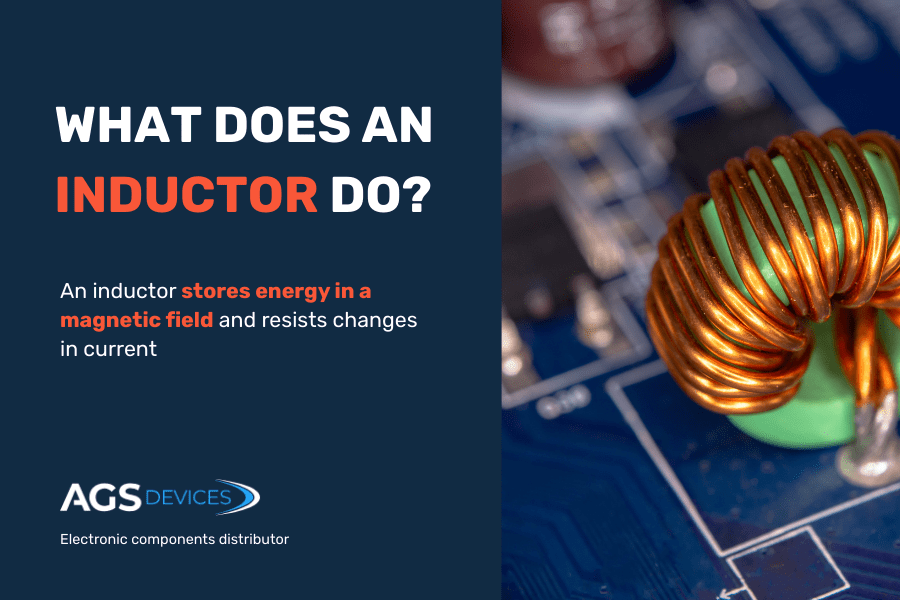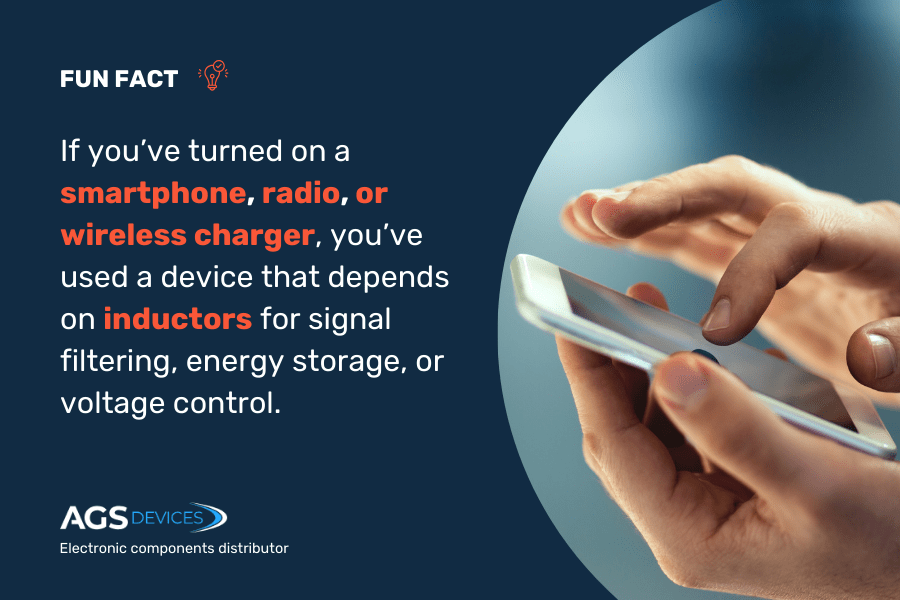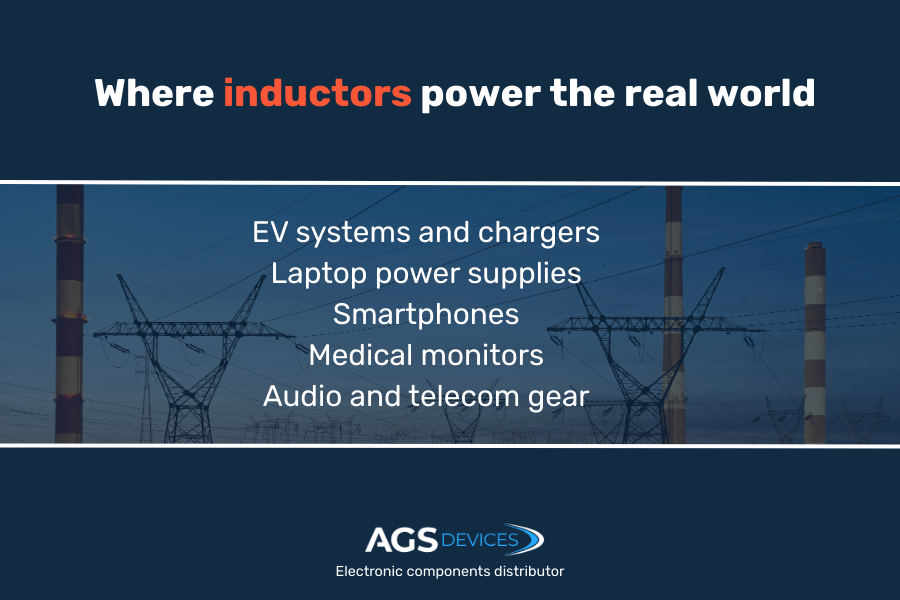
What Does an Inductor Do? Types and Applications: Key Points
- An inductor stores energy in a magnetic field when electrical current flows through it and resists sudden current changes.
- Nearly 25% of global inductor demand comes from the automotive sector, driven by the rise of electric vehicles (EVs) and advanced driver-assistance systems (ADAS)
- Choosing the right type of inductor (air-core, ferrite-core, toroidal, etc.) can affect performance, footprint, and sourcing lead time
- Inductors are critical in power supplies, RF circuits, and EMI suppression as they help stabilize voltage, eliminate noise, and manage current in both AC and DC applications
- Inductors are passive components, meaning they don’t generate power themselves but work alongside other components like resistors and capacitors to shape electrical behavior
The global market for inductors is expected to reach over $11 billion by 2032, driven by demand in automotive electronics, industrial automation, and power management systems.
Inductors are the driving force behind the market growth and a key component for energy storage and current control in modern circuits. This passive component stores energy in a magnetic field, making it essential for everything from power regulation to noise filtering.
This guide will cover:
- What inductors do and how they work in a circuit
- Key use cases across industries like automotive, medical, and industrial systems
- The different types of inductors and their characteristics
What Does an Inductor Do?
An inductor stores energy in a magnetic field and resists changes in current, and it’s an essential component for stabilizing and managing electrical flow in a circuit.
When current flows through its coiled wire, the inductor generates a magnetic field — and if that current suddenly changes, the inductor pushes back, helping to smooth out fluctuations and protect the rest of the circuit.
Real-world examples of what inductors do:
- Power supplies: Used in AC-to-DC converters and switching regulators to prevent surges and stabilize voltage output.
- Audio electronics: Filter out unwanted frequencies to improve sound quality in speakers and amplifiers.
- Electric vehicles: Manage power in high-voltage battery systems and motor controllers.
- Wireless chargers: Create magnetic fields to transfer energy wirelessly to compatible devices.
Without inductors, power systems would be unstable, audio would be noisy, and critical electronics could be vulnerable to damage.
How Does an Inductor Work?
By creating a magnetic field around its coil, an inductor resists sudden changes in current, helping regulate power, filter signals, and store energy in circuits.
At its core, it’s just a coil of wire, often wrapped around a core made of air, iron, or ferrite.
But controlling current flow is anything but simple.
When electrical current flows through the coil, it produces a magnetic field around it.
When a circuit switches off or a load suddenly varies, the current tries to change quickly, causing the magnetic field to collapse and push back. This response creates a voltage (called back EMF) that opposes the change, keeping currents flowing steadily.
Core Behaviors of Inductors
Inductors aren’t just passive coils — they actively shape how current behaves in a circuit. Here’s how they operate on a deeper level:
- The role of magnetic fields: Inductors create a magnetic field that strengthens as current increases. This magnetic property allows them to resist sudden current changes, making them ideal for filtering, noise suppression, and energy regulation.
- Time delay and energy storage: Inductors store energy in their magnetic fields — unlike capacitors that store voltage. When current starts to fall, the inductor releases this energy, helping maintain current flow and smooth out voltage dips or spikes in power supplies and converters.
- Inductance and reactance: Inductance, measured in henries (H), defines how much an inductor resists current changes. In AC circuits, resistance operates in parallel with a reactance and increases as frequency rises. That’s why inductors are essential in low-pass filters, allowing low frequencies to pass while blocking higher ones.

Types of Inductors and Their Unique Roles
Depending on the application, you’ll find different inductor types designed with specific cores, shapes, and performance characteristics.
Here’s a breakdown of the most used types and what sets them apart.
1. Air-Core Inductors
These inductors don’t use any magnetic material in the core except air. While they don’t store as much energy as other types, they’re perfect for high-frequency applications where minimal core losses are essential.
Use case: Air-core inductors are used in RF circuits, such as radio transmitters and antennas, because they offer clean, predictable inductance without magnetic interference.
2. Iron-Core Inductors
Iron-core inductors have a ferromagnetic core that increases inductance and energy storage. They’re ideal for low-frequency, high-current applications, but they tend to experience higher energy loss due to core saturation.
Use case: Commonly found in audio equipment and power supplies, where higher inductance and current handling are more important than speed.
3. Ferrite-Core Inductors
Ferrite cores strike a balance between performance and efficiency. These are often used in switching regulators and EMI suppression, as they offer high inductance in a compact size and perform well at medium to high frequencies.
Use case: Inside your laptop’s motherboard, you’ll find ferrite-core inductors that help reduce noise and regulate power to the processor.
4. Toroidal Inductors
Toroidal inductors are shaped like a donut (toroid) and offer excellent magnetic field containment, which reduces EMI. They’re space-efficient and typically used where compact, low-radiation performance is needed.
Use case: Used in medical imaging systems and high-end audio amplifiers, where low interference and smooth signal processing are critical.
5. Variable Inductors
As the name suggests, these allow users to adjust inductance manually, usually via a movable magnetic core. They’re used in circuits where tuning or fine adjustment is necessary.
Use case: Found in RF transmitters and analog radios, enabling precise tuning of frequency bands or impedance matching.
Where Are Inductors Used? Key Applications Across Industries
Inductors aren’t just theoretical components — they’re hard at work in everything from your smartphone to power grids.
1. Power Supply Systems and DC-DC Converters
Inductors are essential in power electronics manufacturing, especially in voltage regulation circuits like buck and boost converters. They help smooth out fluctuations, store energy during switching cycles, and reduce ripple in DC outputs.
Example: In a laptop charger, an inductor works with a switching regulator to deliver stable voltage to your device without overheating or wasting energy.
2. Signal Filtering in Communication Devices
Many RF (radio frequency) and audio frequency filters use inductors to either block or allow specific frequency ranges. When paired with capacitors, they form LC circuits that are crucial in tuning radios, modulating signals, and reducing noise.
Example: Your smartphone’s antenna system likely includes inductors to help isolate communication bands and improve signal clarity.
3. Industrial and Automotive Electronics
In high-power environments like automotive and industrial systems, inductors manage power spikes, electromagnetic interference (EMI), and current regulation. They’re especially critical in electric vehicles (EVs) and hybrid systems, where they support regenerative braking and battery charging.
Example: In electric cars, inductors are used in onboard chargers and inverters to efficiently transfer power to and from the battery.
4. Medical and Consumer Devices
Inductors in medical equipment support precise signal filtering and stable power delivery, especially in imaging and monitoring systems. In consumer electronics, they’re often hidden in power supply circuits, helping prolong battery life and protect sensitive components.
Example: In portable ECG machines, inductors ensure smooth power flow and eliminate noise that could interfere with accurate readings.

What Does an Inductor Do? Types and Applications: Key Takeaways
Inductors resist changes in current and smooth out voltage fluctuations, making them vital in AC-to-DC converters and power supply circuits.
- Different types of inductors serve different needs. From air-core inductors used in high-frequency RF systems to ferrite-core inductors for filtering and energy storage.
- They’re widely used across industries, including automotive (e.g., EV charging systems), industrial automation (e.g., motor drives), and consumer electronics (e.g., wireless chargers).
- Understanding how inductors work helps engineers design better, more efficient systems — especially in applications that demand clean power delivery and stable performance.
- Sourcing high-quality inductors from AGS Devices ensures compliance, long-term reliability, and seamless integration into your BOM.
Why Source Inductors From AGS Devices?
At AGS Devices, we understand that the performance of any electronic system begins with the reliability of its components, which start with inductors.
Whether you’re designing for high-frequency communications, industrial automation, or power management in medical and consumer electronics, we supply inductors that meet strict quality, performance, and compliance standards.
In addition to inductors, AGS Devices supports your supply chain with a full range of electronic components, including:
- Power Supply Distributors
- Optoelectronics
- Circuit Protection
- Interconnects
- Passive Components Electronics
- Electronic Testing Equipment
- Electromechanical Devices
Our team is here to help you reduce sourcing lead times, manage BOMs, and maintain quality at every stage of your build. With responsive service, strict quality controls, and global component access, AGS Devices is the trusted partner engineers and procurement teams rely on.


